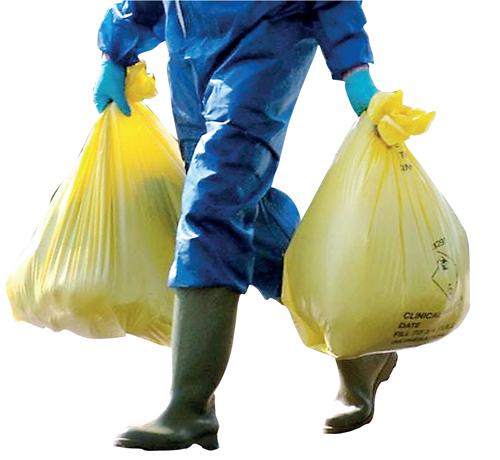02 Jul 2020 - {{hitsCtrl.values.hits}}
@Piyumi_Fonseka on Twitter
Hospital waste management is an important environmental and public safety issue, due to the infectious and hazardous nature of the waste. Daily Mirror Eye received reports and complaints from residents in Seelawathi Perera Mawatha, Werahera, Boralesgamuwa over health risks they have been facing due to the incinerator of Sir John Kotelawala Defence University Hospital (KDUH) in Boralesgamuwa. They complained that they did not have fresh air due to the disgusting smoke coming from the incinerator located two meters away from the line of residences.
With the COVID-19 pandemic, the situation has worsened the fear among the residents of this area as the KDU Hospital is one of the selected hospitals that treat COVID-19 patients. Thirty beds in the Intensive Care Unit (ICU) of the KDUH have been accommodating patients infected with Coronavirus.
According to the Health Ministry, there is a national colour code and guidelines introduced by the Central Environment Authority (CEA) concerning the segregation of clinical waste. In 2006, a General Circular has been issued for every institution in the Health Sector, introducing a National Colour Code for Segregation of Hospital Waste.
According to the circular, yellow bags are used to segregate infectious waste. Infectious waste can be defined as waste that is suspected to contain pathogens such as bacteria, virus, parasites or fungi in sufficient concentration or quantities to cause disease in susceptible hosts.
A health worker at KDU Hospital who requested not be identified told Daily Mirror Eye that the clinical waste burnt in their hospital were from yellow colour bags and they include sharps such as needles and scalpels, contaminated materials or equipment that have been in contact with infected patients and biological waste including blood and tissues.
According to CEA regulations, an incinerator should be operated with a minimum impact on the environment and human health.
 The generator who dispose of these waste and operate an incinerator on-site have to obtain two types of licenses. As per the Gazette No. 1534/18 dated 02/01/2008, published under the National Environmental Act, all Health Care Centres including hospitals should obtain an Environmental Protection License and a Scheduled Waste Management License from the Central Environmental Authority.
The generator who dispose of these waste and operate an incinerator on-site have to obtain two types of licenses. As per the Gazette No. 1534/18 dated 02/01/2008, published under the National Environmental Act, all Health Care Centres including hospitals should obtain an Environmental Protection License and a Scheduled Waste Management License from the Central Environmental Authority.
The creation, collection, transport, storing, clearing, recycling, disposal or erection of facilities for garbage disposal must be under scheduled waste management licenses.
Our Investigation found that the KDU Hospital has none of the above licenses. Director-General of CEA Hemantha Jayasinghe and Waste Management Director of the CEA Ajith Weerasundra confirmed the revelation.
“It took two days for us to check all documents and we couldn’t find any document concerning the maintenance of an incinerator at KDUH,” Weerasundara confirmed to Daily Mirror Eye.

Improper burning of clinical waste poses health risks to those exposed directly to the smoke. It especially affects people with sensitive respiratory problems as well as children and the elderly. Over time, exposure to smoke can increase the risk of developing heart disease and even cancer.
|
|
“It is difficult to explain the smoke that is coming from the chimney. The colour of the smoke is also different. Sometimes, it is pitch black and sometimes it is white as cream. The wind makes the smoke spread across the atmosphere in the vicinity.
“I complained in writing to the Environment Division, PHI and Director of the KDU Hospital. One day, the smoke was so bad that we couldn’t stay in our homes. When we inquired, the hospital authorities said the chimney in Kalubowila Hospital was broken. Therefore, the clinical waste of that hospital was also brought to the KDU and burnt.
They promised us not cause further problems due to the chimney. We felt quite relieved after that. Nonetheless, the burning activities started again as usual after a few days of that promise. I went to meet then KDU officials again. They told us that even their workers had faced issues due to the smoke of the chimney which is why they decided to provide them with safety outfits etc. Our houses have existed way before the hospital came up. The view of the KDU Hospital from the front is beautiful and looks posh. But, the residents living behind the hospital are living in hell.”
“KDU Hospital has been operating for the last three years’. When they were constructing the hospital, they also built a chimney to burn waste. In a hospital, there are different types of waste and there are also different methods to dispose of the waste. What happens in the KDU is they don’t properly get rid of their waste. They burn all the waste materials together. When all the different types of waste are burnt without any segregation, it creates different types of gases. Certain gases which are less heavy than air come down and stay in the air.
Residents around this chimney of the KDU are suffering because of this waste management system the KDU Hospital is practising. The smoke is unbearable. Everyone here including children are suffering because of this. We have breathing problems and other illnesses. This has been happening for the last two-three years’ time. We have complained constantly and we have informed the senior management of the KDU Hospital as well. But, no action has been taken so far. A hospital is to look after the people and care for the people. But, what happens here is otherwise.”
 Meanwhile, numerous attempts made by team Eye to interview the management of the KDU Hospital were unsuccessful. For our every attempt requesting their comment or a site visit to the hospital incinerator unit, the top management of the hospital responded that the hospital officials remain too busy or the management had too many meetings to accommodate our requests.
Meanwhile, numerous attempts made by team Eye to interview the management of the KDU Hospital were unsuccessful. For our every attempt requesting their comment or a site visit to the hospital incinerator unit, the top management of the hospital responded that the hospital officials remain too busy or the management had too many meetings to accommodate our requests.
However, when contacted, Biomedical Engineer at the KDUH, Kodikara said that the incinerator was built following standard height. He also said that they would use a blower to re-circulate the smoke to provide cleaner air emissions. Kodikara informed us that we could visit the incinerator unit, but when asked for an appointment, never confirmed a date.
The residents said that they had written to many government institutions, but to no avail. At the end of the day, being trapped inside their houses is the only choice left for them.
“There are so many kids in these houses. They easily get ill because of this toxic smoke. The Cancer Hospital is also nearby. At this rate, in future, that is where we will have to end up in.”
“We always keep our doors and windows closed to prevent smoke from coming inside our houses. Therefore, we don’t get any fresh air to breathe. My children are suffering from wheezing. The smoke of the waste is unbearable. Following our complaints, instead of solving the issue, they covered the burning area with aluminium roofing sheets.”
The troubled residents have complained to the Mayor of Boralesgamuwa as well. This is what he had to say.
"I have received a complaint from the troubled residents through the Public Health Inspector (PHI) in the area. Following the complaint, I met the higher officials of the KDU Hospital. We were told that there was a breakdown in one of the hospitals in our area that was why the load of the smoke was larger than usual. They also promised not to let it happen again.
“Other than from meeting the officials, I didn’t take any action in writing because I had faith in the promise they gave us. However, I am still receiving complaints from the residents. That means they are still facing the issue because of the chimney. Now that you all have also met me and inquired about this issue, I am going to speak to the KDU officials once again in writing with copies for Medical Officer of Health (MOH) and the Ministry of Defence, demanding immediate action. I am also demanding an immediate report on this issue from the MOH.”
Although the country does not have a high rate of waste production in comparison with other South Asian countries, it’s waste management system is still not developed. There are laws and regulations which were introduced to take action against such illegal waste generation practices but the enforcement of the law is still not satisfactory.
Among the type of waste being produced in the country, issues with the management of hazardous hospital waste have made headlines even in the past. In December 2019, twelve containers of clinical waste had been sitting within the Karapitiya Hospital over weeks. In September 2019, a profiteering racket where waste from hospitals and clinics are dumped along the streets was exposed and stocks of clinical waste were discovered discarded on the Malwana-Dompe Road in Puhuruwila. While the country fails to manage its own hospital waste, the import of clinical waste is also a growing concern. In July 2019, the rotting waste including discarded hospital waste was discovered in more than 100 containers, which had been imported under the cover of metal recycling.
Poor management of clinical waste is a major problem in Sri Lanka. An audit report issued by the National Audit Office (NAO) last year found that clinical waste from hospitals throughout Sri Lanka is disposed of dangerously with incinerators running at below optimum levels, ash and hazardous waste causing a widespread risk to humans. The audit examined 17 hospitals in ten districts across seven provinces.
The responsibility of highly infectious health care waste processes belongs to the generator. Until its final disposal, it is their responsibility. It is also the law. The biggest irony is that the KDU, run by the Defence Ministry, the highest office for the enforcement and maintenance of law and order in Sri Lanka, is also maintaining this incinerator unit with no licenses. If the premier law enforcement authorities fail to follow rules and regulations, what can we expect from the general public?
| Eye is Dailymirror ’s segment to engage with the public through investigative journalism in order to spark action. If you have any issues which deserve to be told in the Eye and which would otherwise go unreported, write to us [email protected] or Deputy Editor - Investigations, Dailymirror, Wijeya Newspapers, No. 8, Hunupitiya Cross Road, Colombo 02, Sri Lanka. |
04 Jan 2025 3 hours ago
04 Jan 2025 3 hours ago
04 Jan 2025 4 hours ago
04 Jan 2025 4 hours ago
04 Jan 2025 5 hours ago